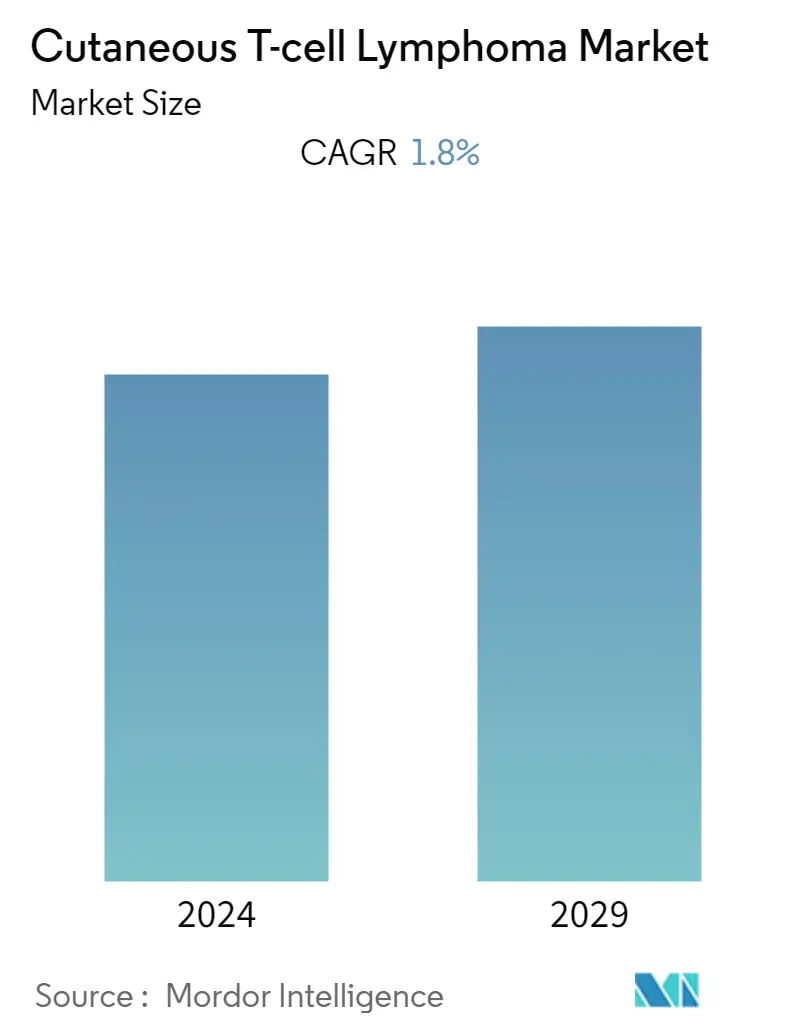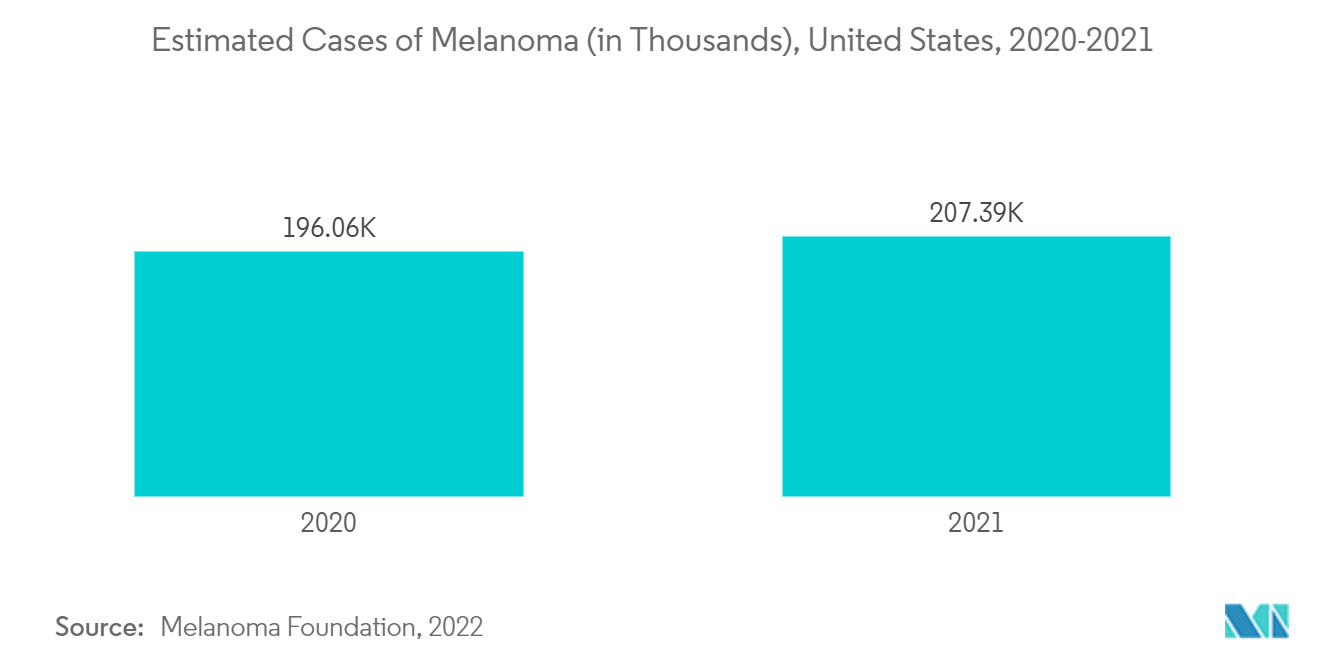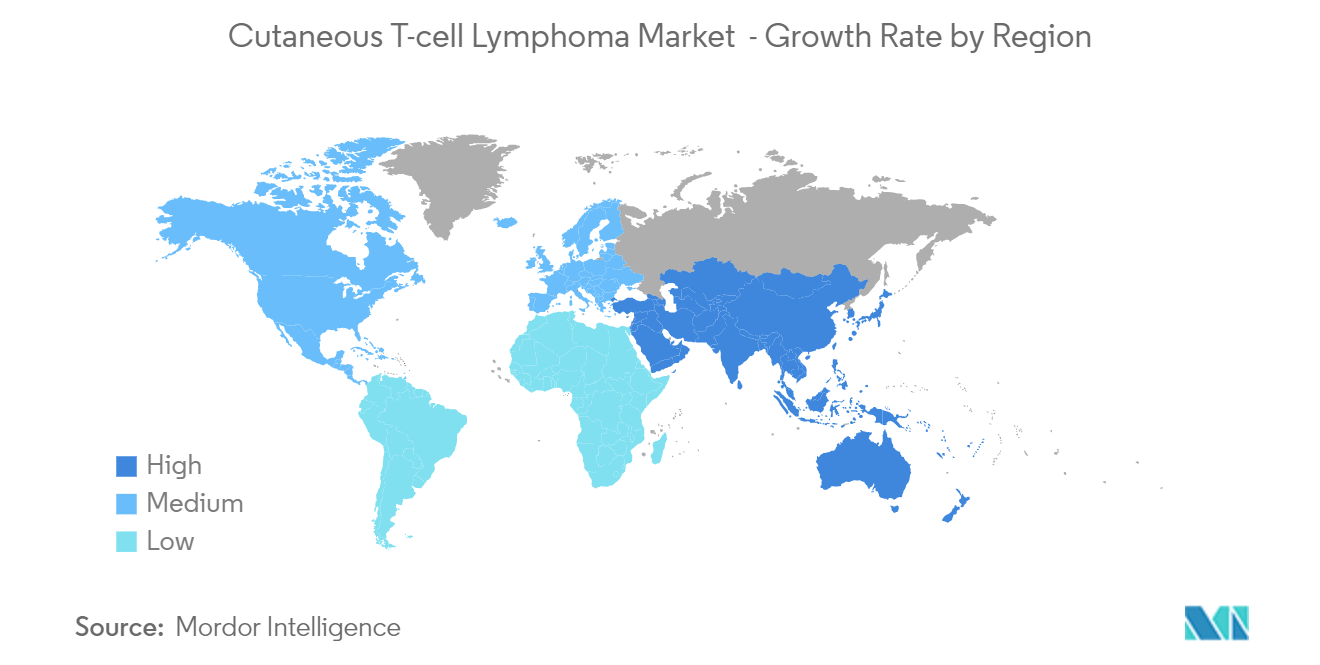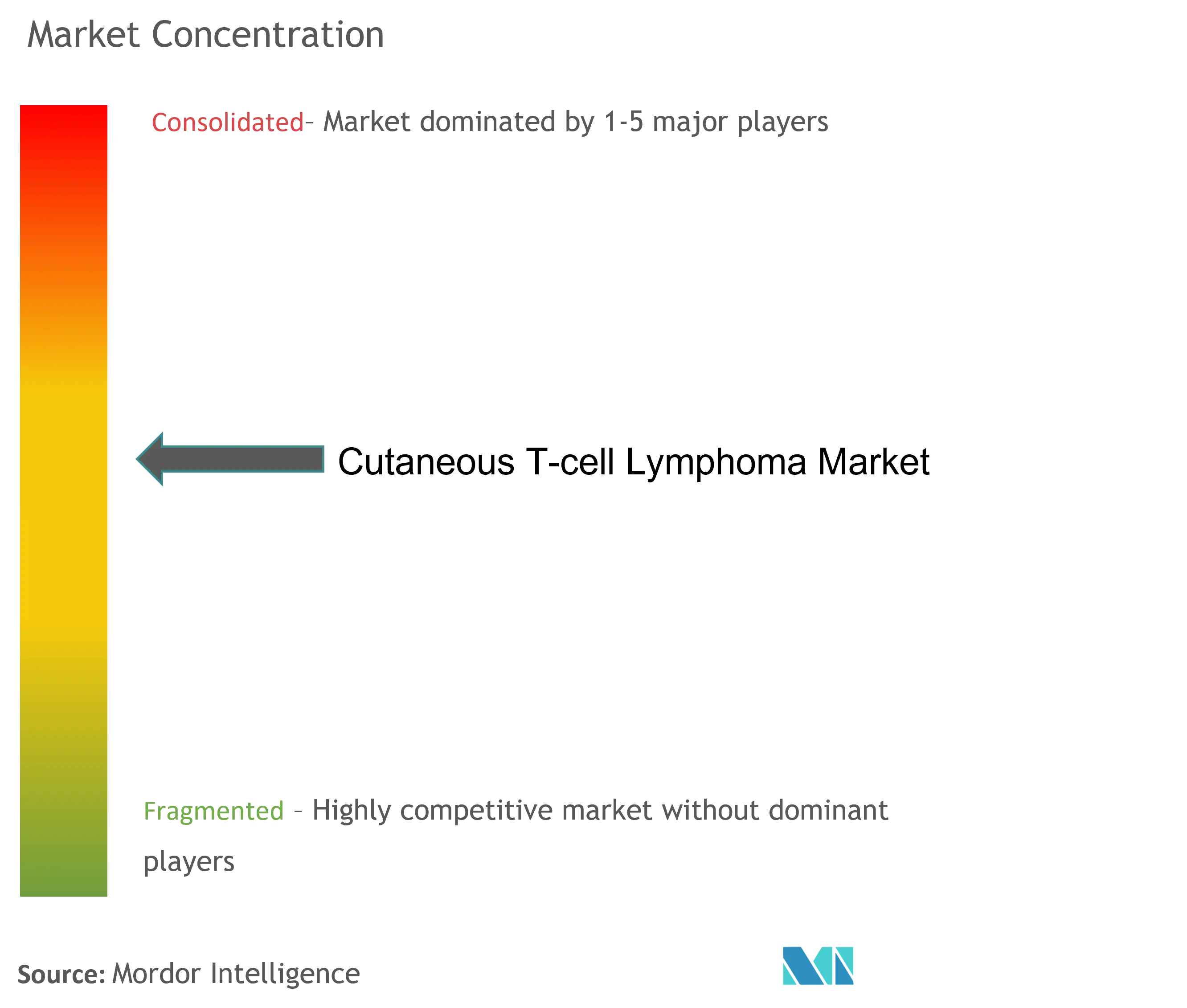Cutaneous T-Cell Lymphoma Market Size

| Study Period | 2021 - 2029 |
| Base Year For Estimation | 2023 |
| CAGR | 1.80 % |
| Fastest Growing Market | Asia Pacific |
| Largest Market | North America |
| Market Concentration | Medium |
Major Players
*Disclaimer: Major Players sorted in no particular order |
Cutaneous T-Cell Lymphoma Market Analysis
The Cutaneous T-cell Lymphoma Market is expected to witness a CAGR of 1.8% over the forecast period.
As most elective treatments were deferred due to the outbreak of the COVID-19 pandemic, the cutaneous T-cell lymphoma (CTCL) market was also significantly impacted. However, delayed treatment was not recommended for severe diseases such as cancer. Thus, necessary guidelines and measures were put forth to allow CTCL treatments amid the pandemic with all protective measures. The research article published in October 2021 by The European Journal of Cancer concluded that the reported cases suggest that disease flare-ups may be associated with the overproduction and exhaustion of CD4+/CD8+ T cells expressing CD30 after stimulation by the adenovirus. Thus, the chances of increased progression of cutaneous T-cell lymphoma post-COVID-19 were high. Therefore, the COVID-19 pandemic created the need for better care and treatment options for CTCL patients and hence has had a significant impact on the growth of the market.
The factors driving the market growth majorly include the growing burden of lymphoma cases coupled with the increasing geriatric population. Additionally, the fast approval of procedures by regulatory authorities and increasing clinical studies are also contributing to the growth of the market.
The launch of products and the support of the regulatory bodies for the fast approval of drugs in many countries are also propelling the growth of the market. For instance, in May 2021, Soligenix was awarded an "Innovation Passport'' for HyBryte (hypericin) for the treatment of early-stage CTCL in adults under the United Kingdom's (UK's) Innovative Licensing and Access Pathway (ILAP).
Additionally, the increasing number of clinical trials focusing on new drugs and treatments for the disease may boost the growth of the market in the future. For instance, as per clinicaltrials.gov, the research study titled "A Phase I Study With an Expansion Cohort of Duvelisib and Nivolumab in Mycosis Fungoides (MF) and Sezary Syndrome (SS)" was sponsored by the National Cancer Institute, started in May 2021, and is expected to be completed by May 2025. The trial's objective is to determine whether intra-patient fluctuations in serum cytokine levels can be used to predict whether duvelisib and nivolumab work against cutaneous T-cell lymphoma. The positive results from such studies could lead to the entrance of new drugs or effective treatments into the market, which is expected to boost the growth of the market over the forecast period. Similarly, in April 2022, Citius Pharmaceuticals Inc. reported topline results from the pivotal Phase III trial of I/ONTAK (E7777), an engineered IL-2-diphtheria toxin fusion protein, for the treatment of patients with persistent or recurrent CTCL.
Thus, owing to the abovementioned factors, the market is expected to show growth over the forecast period. However, the high cost of treatment may hinder the growth of the market.
Cutaneous T-Cell Lymphoma Market Trends
This section covers the major market trends shaping the Cutaneous T-cell Lymphoma Market according to our research experts:
Mycosis Fungoides Segment is Expected to Register a Significant Growth in the Forecast Years
Mycosis fungoides (MF) is the most frequent type of cutaneous T-cell lymphoma, which usually involves the skin and grows slowly over many years. It is not easy to diagnose, especially in the early stages. MF is more common in men compared to women, in blacks compared to whites, and in the elderly population compared to younger people.
According to the article published by StatPearls in April 2022, Mycosis fungoides had an incidence of around 6 cases per million per year in Europe and the United States. This accounts for 4% of all non-Hodgkin's lymphoma cases. The same source also reported that it is more common in adults over 50 years of age, with a male-to-female ratio of between 1.6 and 2. Additionally, the article further detailed that the disease is more common among blacks than Caucasians or Asians. Thus, the high prevalence of mycosis fungoides is expected to boost segment growth.
Furthermore, regulatory organizations such as the United States Food and Drug Administration and the European Medicines Agency have given special designations to most medications developed for mycosis fungoides. Many of these drugs have been given particular classifications, such as orphan drugs and breakthrough therapy. For instance, in June 2020, Kyowa Kirin, a Japan-based drug maker, launched Poteligeo in Europe. It would be able to treat patients with Sézary syndrome, mycosis fungoides, and rare cancers.
Thus, all the factors mentioned above, such as the rising prevalence of mycosis fungoides and product launches, will boost the segment's growth over the coming years.

North America dominates the Cutaneous T-cell Lymphoma Market
North America dominated the market owing to the increased demand for advanced treatment options and early adoption of new technologies.
According to the American Cancer Society's 2022 statistics, there will be an estimated 80,470 new cases of non-Hodgkins lymphoma and 89,010 cases of lymphoma in 2022 in the United States. Another source from the same organization reported that T-cell lymphomas make up less than 15% of non-Hodgkin's lymphomas in the United States, while cutaneous T-cell lymphomas account for nearly 5% of all lymphomas. Additionally, according to Leukemia & Lymphoma Society 2021, 186,400 people in the United States were diagnosed with leukaemia and lymphoma in 2021. In addition, 825,651 people lived with lymphoma in the United States, 152,671 people lived with Hodgkin lymphoma, and 672,980 people lived with non-Hodgkin lymphoma. Such a high burden of the disease creates the need for treatment and thus propels the growth of the market in the region.
In addition, other companies, such as Amgen and Merck, have been working on developing cancer therapies for T-cell lymphomas. Additionally, in September 2021, Soligenix Inc. reported that the Office of Orphan Products Development of the US FDA had granted orphan drug designation to the active ingredient hypericin for treating T-cell lymphoma, CTCL.
Thus, owing to the abovementioned factors, the North American region is expected to show growth over the forecast period.

Cutaneous T-Cell Lymphoma Industry Overview
The cutaneous T-cell Lymphoma market is moderately competitive and consists of several major players. Some of the key players in the cutaneous T-cell lymphoma market include Bausch Health Companies Inc., Celgene Corporation, Helsinn Healthcare SA, Kyowa Hakko Kirin Co., Ltd, Merck & Co. Inc., Seattle Genetics, and Soligenix Inc., which have a presence internationally and provide these products across the world.
Cutaneous T-Cell Lymphoma Market Leaders
-
Bausch Health Companies Inc.
-
Celgene Corporation
-
Helsinn Healthcare SA
-
Kyowa Hakko Kirin Co.
-
Merck & Co. Inc.
*Disclaimer: Major Players sorted in no particular order

Cutaneous T-Cell Lymphoma Market News
- Dec 2022: Citius Pharmaceuticals Inc. announced that the US FDA accepted the company's biologics license application (BLA) for denileukin diftitox, an engineered IL-2-diphtheria toxin fusion protein for the treatment of patients with persistent or recurrent CTCL.
- Jul 2022: Soligenix Inc. received an agreement from the US FDA on an initial pediatric study plan (iPSP) for HyBryte (synthetic hypericin) for the treatment of cutaneous T-cell lymphoma (CTCL).
Cutaneous T-Cell Lymphoma Market Report - Table of Contents
1. INTRODUCTION
- 1.1 Study Assumptions and Market Definition
- 1.2 Scope of the Study
2. RESEARCH METHODOLOGY
3. EXECUTIVE SUMMARY
4. MARKET DYNAMICS
- 4.1 Market Overview
-
4.2 Market Drivers
- 4.2.1 Rise in Lymphoma Cancer Incidence
- 4.2.2 Growing Geriatric Population
-
4.3 Market Restraints
- 4.3.1 High Cost of Treatment
-
4.4 Porter's Five Forces Analysis
- 4.4.1 Threat of New Entrants
- 4.4.2 Bargaining Power of Buyers/Consumers
- 4.4.3 Bargaining Power of Suppliers
- 4.4.4 Threat of Substitute Products
- 4.4.5 Intensity of Competitive Rivalry
5. MARKET SEGMENTATION (Market Size by Value - USD million)
-
5.1 By Type
- 5.1.1 Mycosis Fungoides (MF)
- 5.1.2 Sezary Syndrome (SS)
- 5.1.3 Other Types
-
5.2 By Treatment
- 5.2.1 Radiation Therapy
- 5.2.2 Chemotherapy
- 5.2.3 Immunotherapy
- 5.2.4 Targeted therapy
- 5.2.5 Other Treatments
-
5.3 Geography
- 5.3.1 North America
- 5.3.1.1 United States
- 5.3.1.2 Canada
- 5.3.1.3 Mexico
- 5.3.2 Europe
- 5.3.2.1 Germany
- 5.3.2.2 United Kingdom
- 5.3.2.3 France
- 5.3.2.4 Italy
- 5.3.2.5 Spain
- 5.3.2.6 Rest of Europe
- 5.3.3 Asia-Pacific
- 5.3.3.1 China
- 5.3.3.2 Japan
- 5.3.3.3 India
- 5.3.3.4 Australia
- 5.3.3.5 South Korea
- 5.3.3.6 Rest of Asia-Pacific
- 5.3.4 Middle-East and Africa
- 5.3.4.1 GCC
- 5.3.4.2 South Africa
- 5.3.4.3 Rest of Middle-East and Africa
- 5.3.5 South America
- 5.3.5.1 Brazil
- 5.3.5.2 Argentina
- 5.3.5.3 Rest of South America
6. COMPETITIVE LANDSCAPE
-
6.1 Company Profiles
- 6.1.1 Bausch Health Companies Inc.
- 6.1.2 Celgene Corporation
- 6.1.3 Helsinn Healthcare SA
- 6.1.4 Kyowa Hakko Kirin Co. Ltd
- 6.1.5 Merck & Co. Inc.
- 6.1.6 Seattle Genetics
- 6.1.7 Soligenix Inc.
- 6.1.8 Equillium Inc. (Bioniz Therapeutics)
- 6.1.9 miRagen Therapeutics
- 6.1.10 Innate Pharma
- 6.1.11 Citius Pharmaceuticals Inc.
- 6.1.12 Bristol Myers Squibb
- *List Not Exhaustive
7. MARKET OPPORTUNITIES AND FUTURE TRENDS
** Subject To AvailablityCutaneous T-Cell Lymphoma Industry Segmentation
As per the scope of the report, Cutaneous T-cell Lymphomas (CTCL), also known as skin T-cell lymphomas, are a group of disorders characterized by the abnormal accumulation of malignant T-cells in the skin. CTCLs are cancers of the T lymphocytes that primarily involve the skin, resulting in the development of rashes, plaques, and tumors. CTCL also consists of the blood, lymph nodes, and other internal organs.
The Cutaneous T-cell Lymphoma Market is Segmented By Type (Mycosis fungoides and Sezary Syndrome), Treatment (Radiation Therapy, Chemotherapy, Immunotherapy, Targeted Therapy, and Other Treatments), and Geography (North America, Europe, Asia-Pacific, Middle-East and Africa, and South America). The market report also covers the estimated market sizes and trends for 17 countries across major global regions. The report offers the value (in USD million) for the above segments.
| By Type | Mycosis Fungoides (MF) | |
| Sezary Syndrome (SS) | ||
| Other Types | ||
| By Treatment | Radiation Therapy | |
| Chemotherapy | ||
| Immunotherapy | ||
| Targeted therapy | ||
| Other Treatments | ||
| Geography | North America | United States |
| Canada | ||
| Mexico | ||
| Geography | Europe | Germany |
| United Kingdom | ||
| France | ||
| Italy | ||
| Spain | ||
| Rest of Europe | ||
| Geography | Asia-Pacific | China |
| Japan | ||
| India | ||
| Australia | ||
| South Korea | ||
| Rest of Asia-Pacific | ||
| Geography | Middle-East and Africa | GCC |
| South Africa | ||
| Rest of Middle-East and Africa | ||
| Geography | South America | Brazil |
| Argentina | ||
| Rest of South America |
Cutaneous T-Cell Lymphoma Market Research FAQs
What is the current Cutaneous T-cell Lymphoma Market size?
The Cutaneous T-cell Lymphoma Market is projected to register a CAGR of 1.8% during the forecast period (2024-2029)
Who are the key players in Cutaneous T-cell Lymphoma Market?
Bausch Health Companies Inc., Celgene Corporation, Helsinn Healthcare SA, Kyowa Hakko Kirin Co. and Merck & Co. Inc. are the major companies operating in the Cutaneous T-cell Lymphoma Market.
Which is the fastest growing region in Cutaneous T-cell Lymphoma Market?
Asia Pacific is estimated to grow at the highest CAGR over the forecast period (2024-2029).
Which region has the biggest share in Cutaneous T-cell Lymphoma Market?
In 2024, the North America accounts for the largest market share in Cutaneous T-cell Lymphoma Market.
What years does this Cutaneous T-cell Lymphoma Market cover?
The report covers the Cutaneous T-cell Lymphoma Market historical market size for years: 2021, 2022 and 2023. The report also forecasts the Cutaneous T-cell Lymphoma Market size for years: 2024, 2025, 2026, 2027, 2028 and 2029.
Cutaneous T-Cell Lymphoma Industry Report
Statistics for the 2024 Cutaneous T-Cell Lymphoma market share, size and revenue growth rate, created by Mordor Intelligence™ Industry Reports. Cutaneous T-Cell Lymphoma analysis includes a market forecast outlook 2029 and historical overview. Get a sample of this industry analysis as a free report PDF download.



